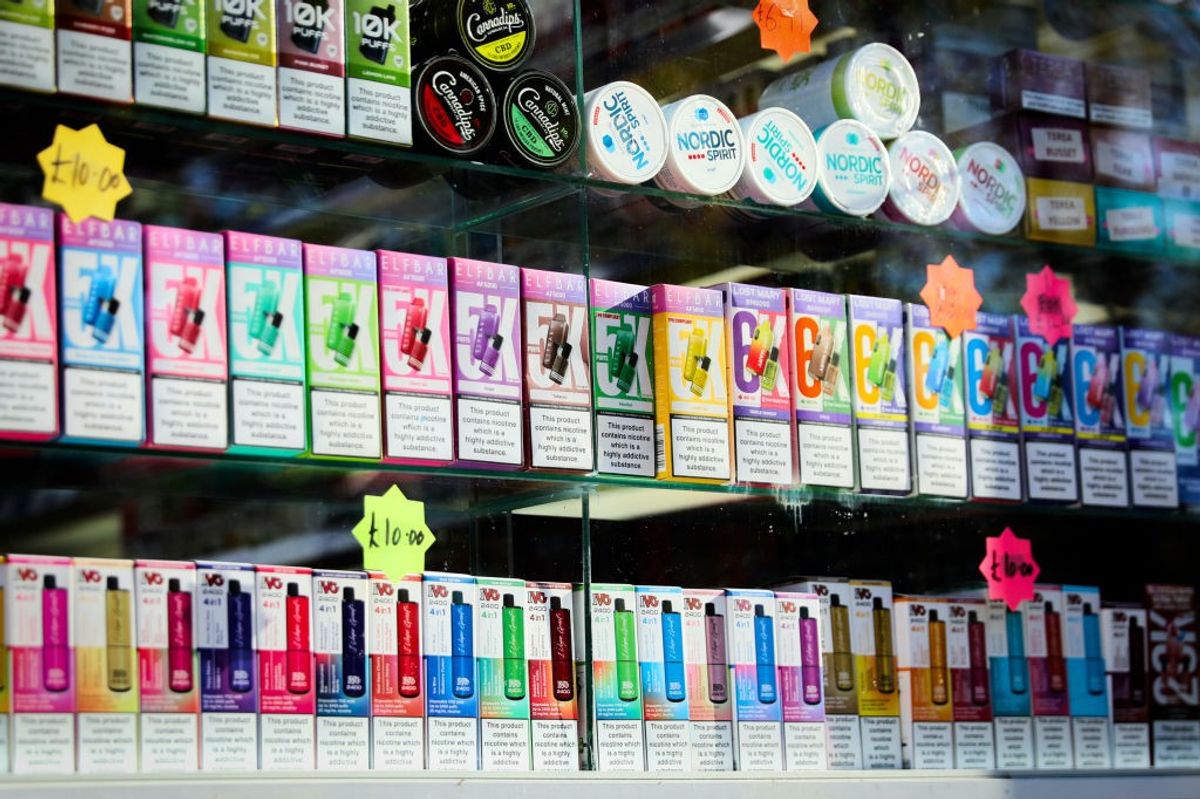For convenience retailers, the landscape of nicotine products has undergone a seismic shift over the past five years. What began as a niche category of vaping devices has blossomed into a diverse ecosystem of alternatives – heated tobacco products, sophisticated reusable vapes with improved technology, and nicotine pouches. These products haven't merely filled a gap; they've created entirely new revenue streams that have more than compensated for declining combustible tobacco sales.
Transition and growth
While the past three years have seen explosive growth in the vaping category, largely driven by the popularity of disposable products, recent data suggest we may be entering a new phase. According to a study published in the journal Addiction by UCL researchers, the proportion of people vaping increased by nearly a quarter each year from January 2022 to January 2024, but has since plateaued.
Even Dr Sarah Jackson of UCL Institute of Epidemiology & Health Care, noted: “Action is likely still required to reduce high vaping rates, but now that the situation has stabilised policymakers may be reassured that it would be sensible to avoid stricter policy options currently under review. Some of the options being considered may be more likely to have the unintended consequence of deterring smokers from using vapes to quit smoking.”
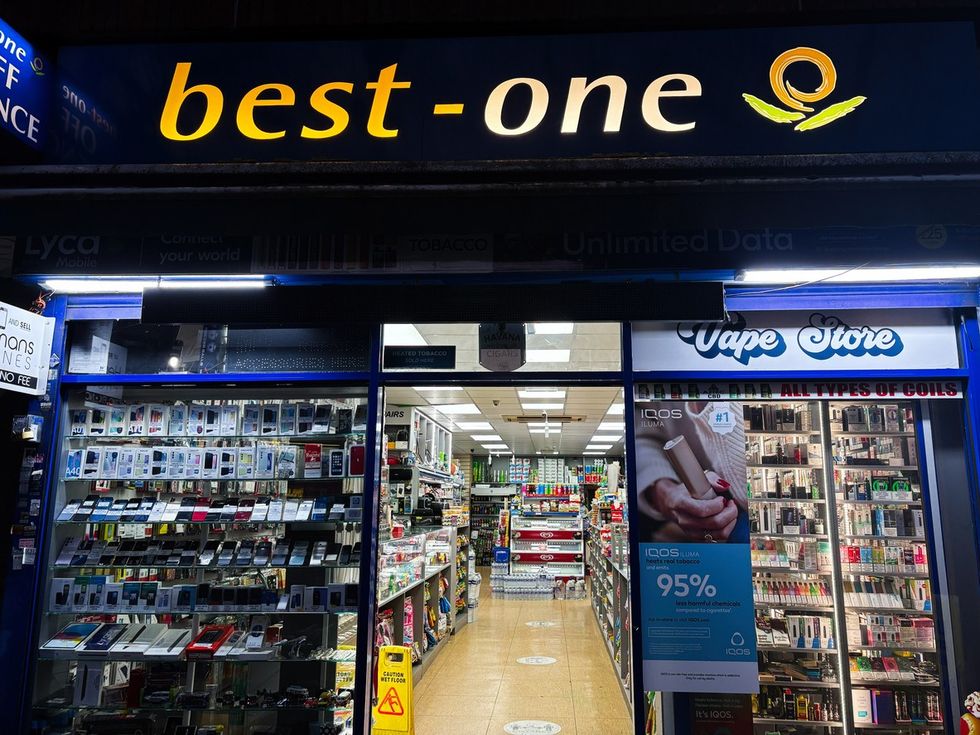
This stabilisation comes as the sector prepares for significant regulatory change. The government's ban on disposable vapes came into force on 1 June, prompting shifts in consumer behaviour even before implementation. The UCL study found a substantial decline in the proportion of vapers mainly using disposable vapes after January 2024, with the proportion among 16- to 24-year-olds almost halving from 63 per cent to 35 per cent.
“Our results also suggest that the government's ban on disposables may have limited impact on vaping rates in general, given that vapers are already moving away from disposable vapes,” Dr Jackson explained. “It seems likely that people using these products will move to re-usable versions rather than stop vaping completely.”
This transition is already evident in sales data. Andrew Malm, UK Market Manager for Imperial Brands, confirms: “The value of disposable vapes within the retail channel has already dropped significantly, from £108 million in November 2023 to £85 million in November 2024. Meanwhile, pod systems have doubled their value within the UK retail channel – increasing from £13 million to £25.6 million [Nielsen/Syndicated Data].”
Public health viewpoint
Amid the commercial shifts, it's important not to lose sight of the public health perspective. Vaping represents a significant harm reduction opportunity, with the Office for Health Improvement and Disparities (formerly Public Health England) maintaining that these products are at least 95 per cent less harmful than traditional cigarettes.
Professor Jamie Brown of UCL Institute of Epidemiology & Health Care reinforces this point: “While it is understandable that policymakers want to take action to reduce vaping among children and never smokers, smoking remains the number one public health priority. These findings should reassure policymakers that they can prioritise measures, such as restrictions on marketing, packaging and display, which are least likely to undermine how helpful vapes are for people trying to quit smoking.”
He adds: “It is important that these measures are introduced alongside other messaging and policies that continue to encourage and support smokers to quit smoking, such as mass media campaigns and the swap to stop scheme.”
Regulatory horizon
The Tobacco and Vapes Bill currently progressing through Parliament represents another significant regulatory development for the sector. While focused primarily on the generational smoking ban, the bill also contains powers to potentially restrict vape flavours, packaging, marketing, and display.
The Department of Health and Social Care (DHSC) has promised further consultation before implementing any flavour restrictions, acknowledging the role flavours play in smoking cessation. In response to a petition opposing flavour restrictions, the DHSC stated: “In considering the specific restrictions we bring forward, we are keenly aware that vaping is rightly used by adults as a tool to quit smoking. Vapes are less harmful than cigarettes, and vape flavours are an important consideration for adult smokers seeking to quit smoking.”
The response added: “That is why we will be consulting further on these measures as soon as possible after Royal Assent of the Tobacco and Vapes Bill,” noting that any drafted regulations would be “subject to parliamentary debate and vote before becoming law.”

The rapid pace of legislative change has raised concerns across the industry. Ian Howell, Public Affairs Manager at JTI UK, highlights the challenges facing retailers: “At a time when convenience stores across the country are facing unprecedented levels of theft, violence and abuse, coupled with serious business pressures from the changes to the National Minimum Wage and National Insurance Contributions, we have been urging the Labour Government to consider the views of retailers before implementing any new legislation.”
Howell particularly emphasises retailer concerns around the generational smoking ban: “Retailers fear a potential generational smoking ban will result in increased violent behaviour in their stores and will lead to more counterfeit tobacco in their communities.” He cites a recent survey showing that “78 per cent of retailers feel like a generational ban would lead to more illicit tobacco in their local area.”
The potential for increased illicit trade is a significant concern. “The latest tobacco duty rises, coupled with the government's Tobacco and Vapes Bill, will likely see more smokers turn to the illicit market, meaning this challenge will only grow in the months ahead for retailers,” Howell warns. “Illicit tobacco is increasingly prevalent in the UK, driven by successive duty increases that push up tobacco prices. JTI data shows a concerning trend: non-UK duty paid cigarettes increased from 23 per cent in 2023 to 30 per cent in 2024, while non-UK duty paid hand-rolling tobacco increased from 34 per cent to 47 per cent in the same period.”
Flavour, cost considerations
As the market shifts away from disposables, retailers need to understand evolving consumer preferences to stay competitive. Andrew Malm of Imperial Brands points to the dominance of fruit flavours across both disposable and pod-based systems: “Fruity flavours dominate consumer preference for both disposable and pod-based devices. For example, in the UK, fruity flavours take the majority sector share within pods – climbing from just under 41 per cent at the end of 2023 to 65 per cent at the end of 2024 [Nielsen/Syndicated Data, November 2024].”
Economic factors are also influencing purchasing decisions. “With the cost-of-living crisis continuing to have an impact on household budgets, customers will be looking for rechargeable devices where there is also a decent range of flavours for the refillable pods or cartridges,” Malm explains. “This gives them the flexibility to try different tastes without having to continually re-purchase the device itself.”
Form factor remains crucial in the transition from disposables to pod systems. Consumers have grown accustomed to the sleek, portable nature of disposables, a consideration manufacturers are addressing with their rechargeable alternatives. “Consumers also want sleek and easy-to-use device formats, which was a key selling point of disposable vapes,” notes Malm. “However, rechargeable pod systems like the blu bar kit offer this portability while also delivering the same high-quality flavours as disposables.”
Competitive edge
For independent retailers wondering how to compete with multiples in this evolving landscape, localisation and customer understanding are key differentiators. “Independents should analyse customer buying habits and stock flavours that sell best locally,” advises Malm. “We'd advise engaging with customers to understand key trends within your store and take notice of the products and flavours that customers are frequently purchasing.”
This approach allows for a curated, yet diverse selection. “Whilst refinement shows a personal touch, offering a variety of products and flavours is important too,” he continues. “Stocking products such as our blu bar kits, as well as replaceable pods in a variety of flavours and essential accessories will help appeal to both current customers and those transitioning from disposables.”

Staff knowledge can be a crucial competitive advantage. “Additionally, providing convenience and education through staff training on pod-based systems is crucial to assist customers during this shift – so they know what product is best for them,” Malm emphasises. “Our Ignite app for example, has up to date information that you and your staff can leverage to remain competitive and in-the-know.”
The presentation of next-generation nicotine products can significantly influence purchasing decisions, especially as consumers navigate the transition from disposables. “Ensuring that all branding or POS is up to date and looks professionally finished, as well as ensuring enough space in the gantry is given to new product launches, will help drive awareness of new products,” says Malm. “This should encourage shoppers to try something new and different – a remarkably important factor with the ban coming into place.”
He recommends “creating an organised, well-lighted space showcasing compliant products for quick identification. Pods and devices should be clearly labelled and arranged by flavour type.”
Adaptation and innovation
Despite the regulatory challenges, tobacco companies and next-generation nicotine manufacturers are adapting rapidly. Investment in research and development has yielded significant improvements in product performance, with advances in battery technology, nicotine delivery systems, and flavour profiles making alternatives increasingly attractive to transitioning smokers.
Imperial Brands has expanded its rechargeable portfolio in anticipation of the disposables ban. “Ahead of the disposable vapes ban and recognising the importance of flavour options as a key purchasing factor for customers, we have recently launched an exciting range of new flavours for the blu pod line,” Malm reveals.
“These pods are compatible with our rechargeable blu bar and other rechargeable blu devices which are due to launch later this year. Available in packs of two, our blu replaceable pods offer customers up to 2,000 puffs of intense flavours – 15 in total – including 11 new additions, such as Strawberry Ice, Kiwi Passionfruit, Mint, Triple Melon and more.”
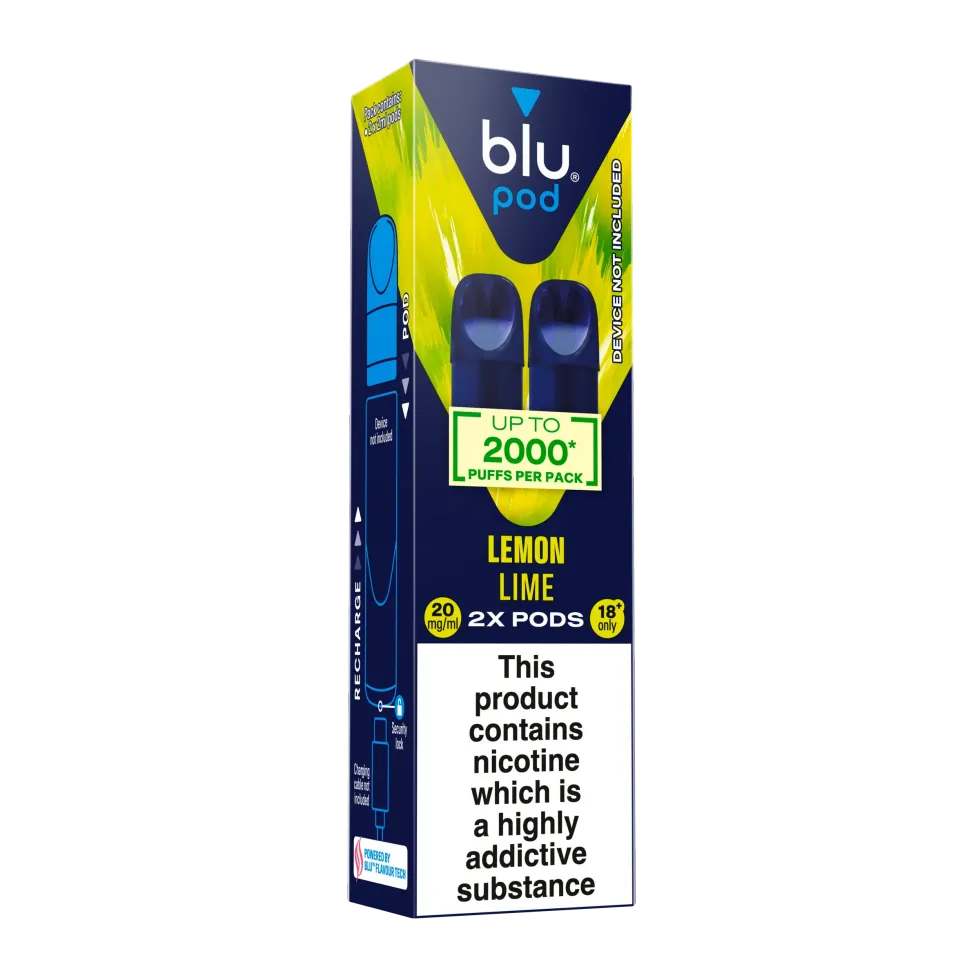
Looking ahead, Imperial is further diversifying its device offerings: “Complementing the successful blu bar kit and blu pod offering, the all-new blu box kit caters for the 25 per cent of disposable vape customers who show a preference for a box format,” explains Malm. “Blu box kit is a great choice for wholesalers and retailers to stock, particularly those with female customers in their 20s who prefer discreet devices which fit within the palm of their hand.”
Philip Morris Limited has expanded its Veev One range with two new flavours: Sour Apple and Cherry. The device features advanced Compact Ceramic heating technology and a low-level e-liquid detection system. “While not risk-free and containing nicotine, which is addictive, Veev One emits on average 99 per cent less harmful chemicals compared to cigarettes,” Philip Morris claims. The expanded portfolio now includes 14 flavours, all containing 1.8 per cent nicotine.
In a category first, Republic Technologies has entered the vaping market with its Smarter range featuring the UK's first no mesh coil pod system. The range includes the compact Smarter Mini (RRP £9.99) providing up to 800 puffs per replaceable pod, and the Smarter 6K (RRP £12.99) enabling up to 6,000 puffs per refill.
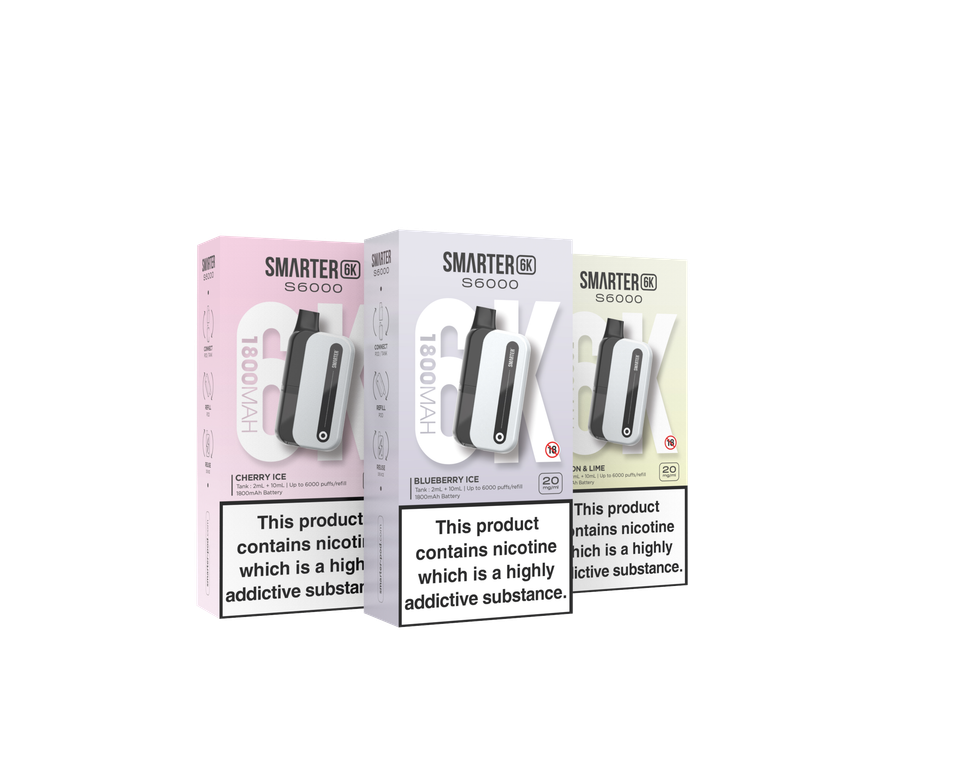
“The Smarter products are just that, breaking new ground with their use of smart, innovative technology,” commented Gavin Anderson, Sales and Marketing Director. “Users will be able to switch pods with little or no residue and the eco-friendly, rechargeable devices will also reduce wastage.”
Riot Labs has launched a four-strong range of 0mg nicotine flavours for its Connex device, including Blueberry Sour Raspberry and Cherry Cola. “In a pivotal year, Connex 0mg will play a crucial role in smokers turning to vaping to help them kick the habit. The device has been designed to be as easy as possible to use, as easy as any disposable vape, featuring a clever closed pod magnetic system and the ability to be recharged 500 times,” said Ben Johnson, Chief Executive and Founder.
The company has also launched Riot X, a “supercharged” collection of 12 maximum intensity flavours. “Flavours are made up of different molecules, and some fade faster than others. By carefully fine-tuning these elements, we’ve created a multi-layered flavour experience that evolves with every puff,” Johnson explained.
SKE has unveiled a portfolio of eight new devices spanning pod systems, refillables and advanced reusables. “This is a defining and significant moment for SKE as we introduce a more diverse product lineup which includes refillable pod systems, open systems with replaceable tanks and vapour-free products, catering for all retail formats and to a wide range of consumers,” said Chris Dong, SKE's UK Regional Director.
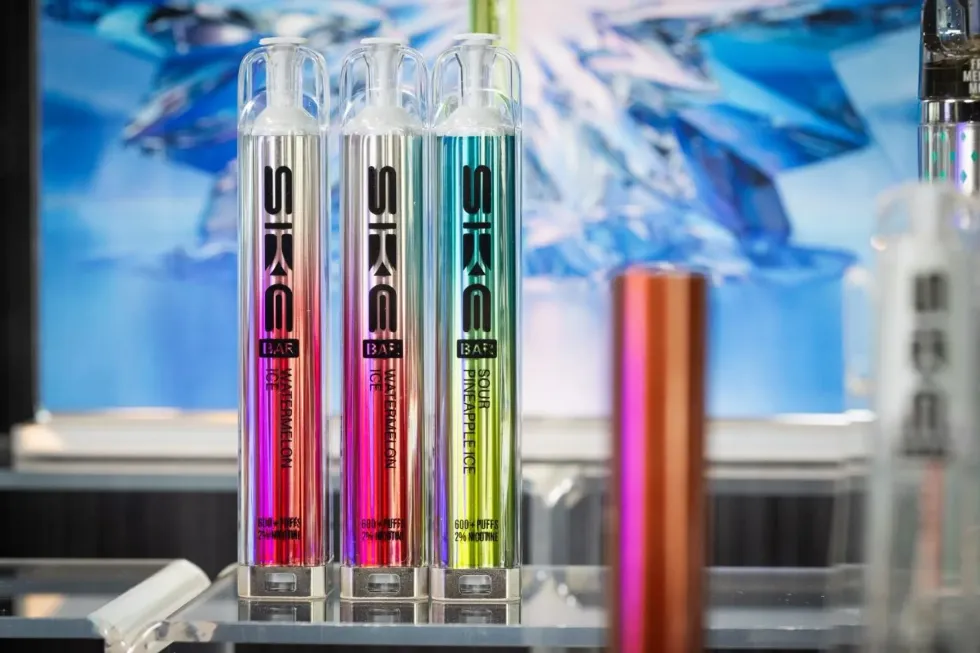
The SKE Bar, one of eight new products launched during the Vaper Expo this month, is a pre-filled pod system which retains the same design and flavour-profile of the company's popular disposables, the SKE Crystal Bar.
The SKE 600 Pro contains magnetically-secured pods, a one-piece PCTG body, anti-leak technology, 400mAh hour battery and fast-charging USB-C port.
Upcoming devices in the new lineup will include a two-pod SKE CL2000 with transparent casing; the compact 8,000-puff SKE Airy 8000; the SKE PULX Air – an entry level open system; the SKE PULX open system which features a 2.21 inch touchscreen display, smartphone Bluetooth pairing and puff tracker; the SKE Edge X with triple-layer leak-proof technology and the SKE Airknows, which features ceramic air heating without vapour production.
Vapes Bars has introduced the Angel 20K, a reusable device offering up to 20,000 puffs with 2 x 12ml pre-filled pods at £11.99 RRP. “As we step into 2025, Angel is setting a new direction for vaping innovation, sustainability, and cost savings,” said Adam Matliwala, Chief Executive at Vapes Bars.
Diversification and new categories
Beyond vaping, the category is seeing growth in other next-generation products. Heated tobacco devices, which heat rather than burn tobacco, have gained traction among smokers for whom vaping doesn't provide a satisfactory alternative. These products deliver a more authentic tobacco experience while significantly reducing harmful emissions compared to combustible cigarettes.
Similarly, nicotine pouches – small, tobacco-free pouches placed between the lip and gum – have emerged as a discreet alternative. Their rapid growth represents another promising avenue for retailers.
The heated tobacco market has matured significantly over the past decade, led by trailblazing innovations like PMI’s IQOS and Japan Tobacco International's (JTI) Ploom series.
In November last year PMI celebrated the tenth anniversary of its IQOS device. While the initial rollout of heat-not-burn technology was deliberate and targeted, its adoption has steadily increased as availability expanded. Today, heated tobacco is a mainstream category, particularly popular among ex-smokers who enjoy the authentic taste of tobacco without the health risks of combustion.
The IQOS system has been instrumental in PMI’s vision for a smoke-free future. “With the debut of IQOS, we launched PMI’s vision of a smoke-free company, creating an opportunity to solve the problem of smoking,” PMI chief executive Jacek Olczak said.
HNB: premium flavours
While much attention has focused on the vaping market ahead of the disposables ban, the heated tobacco category continues to evolve with sophisticated flavour innovations targeting adult smokers seeking alternatives to combustible cigarettes.
Philip Morris Limited (PML), the affiliate of PMI in the UK and Ireland, has recently expanded its TEREA range for the IQOS Iluma heat-not-burn device with the introduction of TEREA Silver, a premium addition now available across grocery, convenience and wholesale channels. The new variant offers “a balanced, toasted tobacco blend gently refined with light aroma notes of spicy herbs,” complementing existing options for IQOS Iluma users who prefer the Amber, Sienna and Russet variants.
“The launch of new TEREA Silver is a further step forward on our mission to support adult smokers in making the switch away from smoking cigarettes,” said Anthony Loinsard, Head of IQOS, UK and Ireland at PML. “For some adult smokers, having responsible access to a preferred flavour can be an important factor in making the switch from smoking cigarettes.”
The expansion brings the full TEREA flavour range to an impressive 16 variants, including six capsule-based TEREA Pearls flavours. This latest addition follows the February launch of two new dual-flavour variants for the innovative TEREA Pearls capsule range: Riviera Pearl and Provence Pearl.
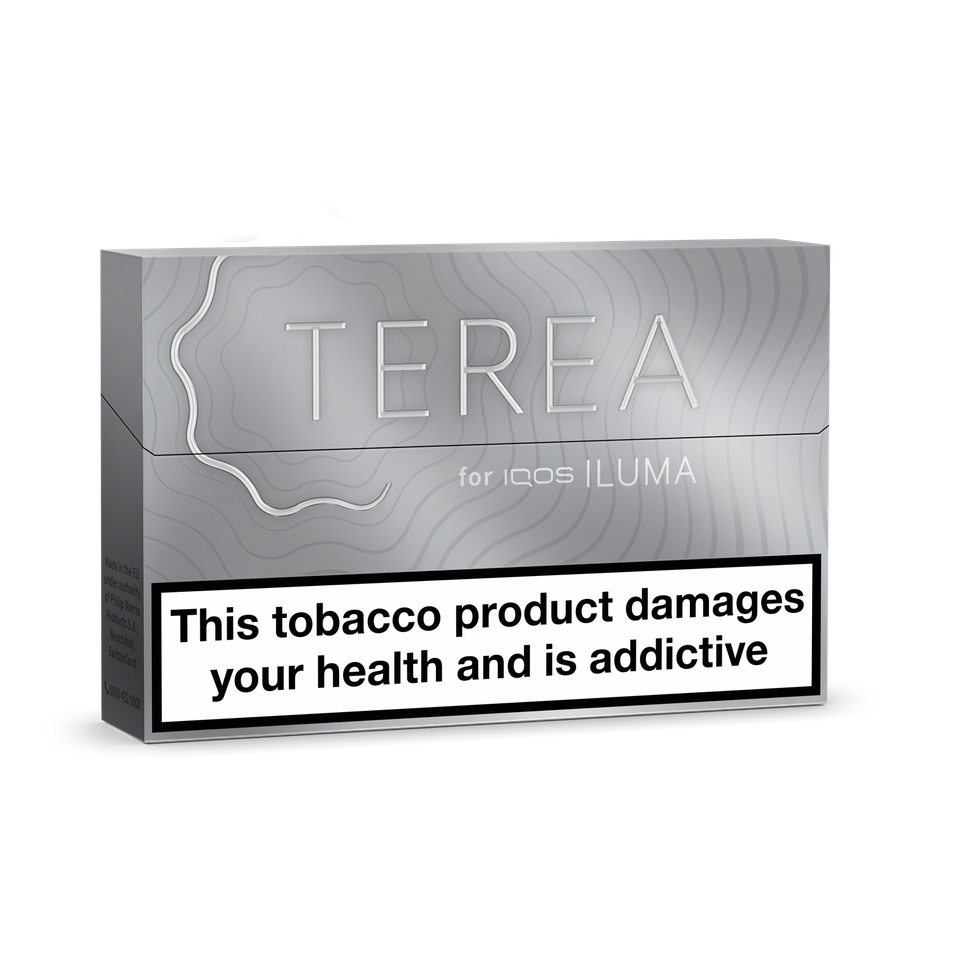
The TEREA Pearls collection features cutting-edge capsule technology allowing users to transition seamlessly from a traditional tobacco blend to a unique flavour with a single click. Early sales data has demonstrated significant consumer interest, with PML reporting that nearly one in five TEREA packs sold in a top-four grocery multiple within the first three months were Pearls products.
“Capsulated heated tobacco products offer retailers a unique proposition for legal-aged nicotine users to seamlessly switch from traditional tobacco blends to unique flavour blends of their choice with a single click,” Loinsard explained. “With the addition of two new flavours, Riviera and Provence, we will continue to strengthen the taste portfolio of IQOS ILUMA, providing an appealing and real tobacco alternative for adult nicotine users who would otherwise return to smoking cigarettes.”
For retailers, the expanded TEREA range presents substantial profit opportunities through attractive profit-on-return (POR) offers. PML also highlights that IQOS ILUMA complements existing gantries, delivering tobacco taste and satisfaction while emitting 95 per cent less harmful chemicals compared to cigarettes. The company claims the system enables users to make savings of up to £3,300 per year compared to conventional cigarettes.
JTI has been another key player in the heated tobacco space. The launch of the Ploom X Advanced device introduced an optimised HeatFlow system for enhanced vapour volume and faster charging capabilities, taking less than 90 minutes to fully recharge. These upgrades, combined with improved EVO tobacco stick flavours like Bronze, Amber, and the new Gold variant, have propelled the brand to new heights.
Pouches: convenience and flavour
The nicotine pouch category continues to demonstrate impressive growth in the UK market, offering retailers a significant profit opportunity as consumer demand surges. Currently worth over £140 million in annual retail sales – excluding online transactions – the category has experienced an exceptional 77 per cent year-on-year volume growth [IRI Marketplace].
The convenience channel is proving particularly fertile ground for growth, with sales nearly doubling in the past twelve months. This rapid expansion can be attributed to several factors, including the versatility of nicotine pouches compared to other next-generation nicotine products.
“We feel confident the ban on disposable vape products will represent a good opportunity for nicotine pouch brands like XQS, as many next gen nicotine users will be looking elsewhere for different next gen products, and pouches offer a very credible alternative. This is largely because, unlike vapes, nicotine pouch users can enjoy them on public transport, at work, at sporting events, concerts or anywhere they like,” explains Prianka Jhingan, Head of Marketing at Scandinavian Tobacco Group UK.
Consumer preferences are clearly shaping product development across the category. While mint flavours currently dominate with an 83.6 per cent market share, fruit flavours are gaining significant traction, currently holding 15.5 per cent of the market according to recent JTI data. Manufacturers are responding with innovative new flavour profiles to meet this demand.
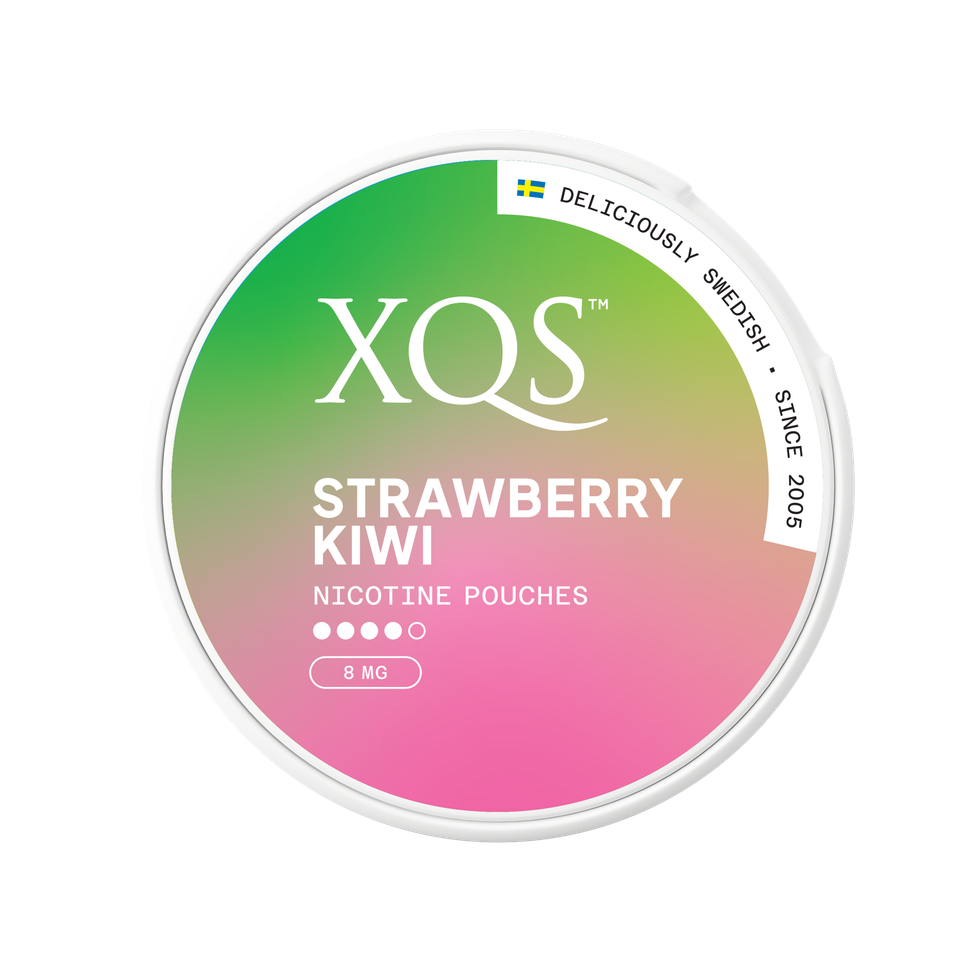
“Fruity flavours are really coming to the fore in the nicotine pouch category and we truly believe XQS offers pouch users exciting taste sensations through our high-quality and long-lasting flavour portfolio,” Jhingan notes.
STG UK has been particularly active in this area, launching five new XQS SKUs this year alone, including Black Cherry, Citrus Cooling, Raspberry Blackcurrant, Strawberry Kiwi and Berrynana Twist. Meanwhile, competitor JTI has expanded its Nordic Spirit range with new variants including Frosty Berry, Frosty Mint, Raspberry, Tropical Mix, and Forest Berries.
“Consumers in this space are seeking bolder flavour experiences and greater variety from nicotine pouches,” said Bruce Terry, Portfolio Brand Manager at JTI UK. “That insight guided the development of our latest Nordic Spirit range, where we placed a strong emphasis on both intensity and diversity of flavours.”
Strength preferences are also evolving, with strong and extra-strong variants now accounting for 60.1 per cent of the nicotine pouch market, according to JTI's research. Manufacturers are responding by enhancing both flavour intensity and nicotine strength.
According to Dor Matot, Head of ZYN at PML, these products appeal not just to former smokers but to a wider audience.
“Nicotine pouches are a versatile, smoke-free alternative suitable for any adult smoker or legal-aged nicotine user. They are ideal for any location or occasion as they provide a cleaner, discreet nicotine experience compared to cigarettes,” he notes.
“They are also popular among poly-users – those using more than one nicotine product. Retailers should view nicotine pouches as fulfilling a diverse range of customer preferences and not limit their approach to a single customer type.”
Philip Morris, through its ZYN brand, has established itself as a formidable player in the UK nicotine pouch market. According to Matot, the category aligns perfectly with broader tobacco trends.
“As the UK moves towards a smoke-free future, it's crucial for retailers to adopt a multi-category approach that caters to consumer need for variety. Nicotine pouches have seen significant growth – ZYN nicotine pouches, in particular, saw a 497 per cent increase in sales volume between December 2023 and December 2024,” he explains.
Price remains a key consideration for consumers in this category. “It's also worth noting there'll always be a good percentage of nicotine consumers who are shopping the category by price and looking for the cheapest option. That's why I'm pleased to confirm that XQS is competitively priced and usually one of the cheapest brands on offer, with an RRP of just £5.50,” says Jhingan.
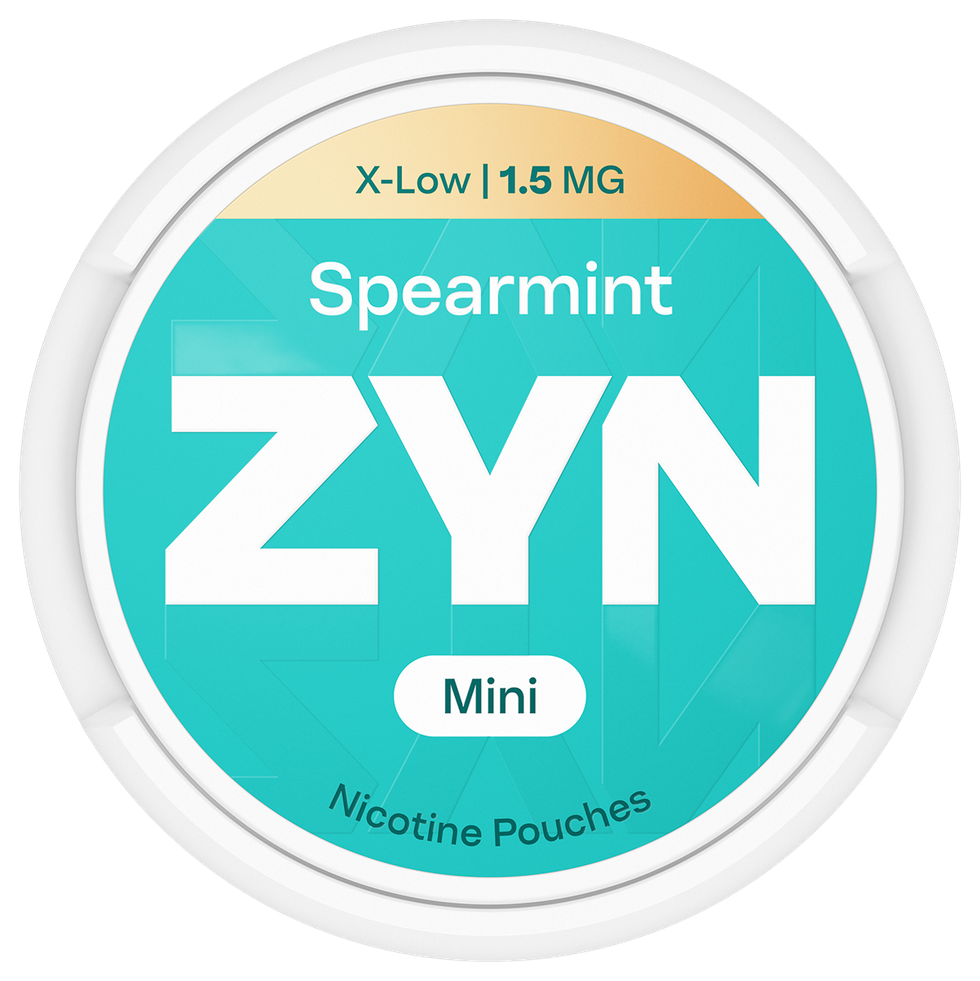
Matot highlights another angle: “ZYN nicotine pouches are priced at £6.50 RRP, whereas the average price of a pack of cigarettes is £16.60. This cost advantage makes ZYN nicotine pouches a budget-friendly alternative for legal-aged nicotine users.”
For retailers, nicotine pouches represent an attractive profit opportunity. “XQS in particular offers one of the highest margins of all pouch brands, which is yet another reason to ensure you are well-stocked,” Jhingan points out.
As the category continues to evolve, new entrants are bringing additional innovation to the market. Angel has recently expanded its portfolio with a brand-new line of nicotine pouches, lozenges, and strips designed specifically for vape- and smoke-free environments. Launched in April, these products offer convenience retailers an additional revenue opportunity.
“With increasing restrictions on vaping and smoking in public spaces – from offices to public transport – consumers are actively seeking ways to manage cravings discreetly,” a spokesperson for Angel explained. The brand highlights several key advantages for retailers, including full compliance with regulations, impulse-driven sales potential, fast turnover, and strong margins. With point-of-sale support and promotional pricing for early stockists, Angel's entry further diversifies the growing nicotine pouch category.
For convenience store owners navigating the evolving next-generation nicotine landscape, staying informed about product innovations, regulatory changes, and consumer trends has never been more important. While challenges undoubtedly lie ahead, the category continues to offer significant commercial opportunities alongside potential public health benefits – a rare alignment of commercial and societal interests that savvy retailers are well-positioned to leverage.




